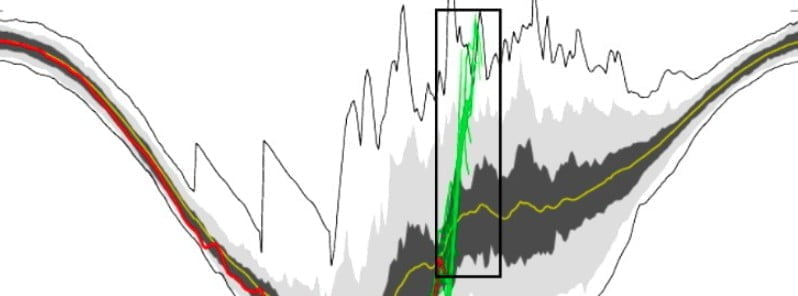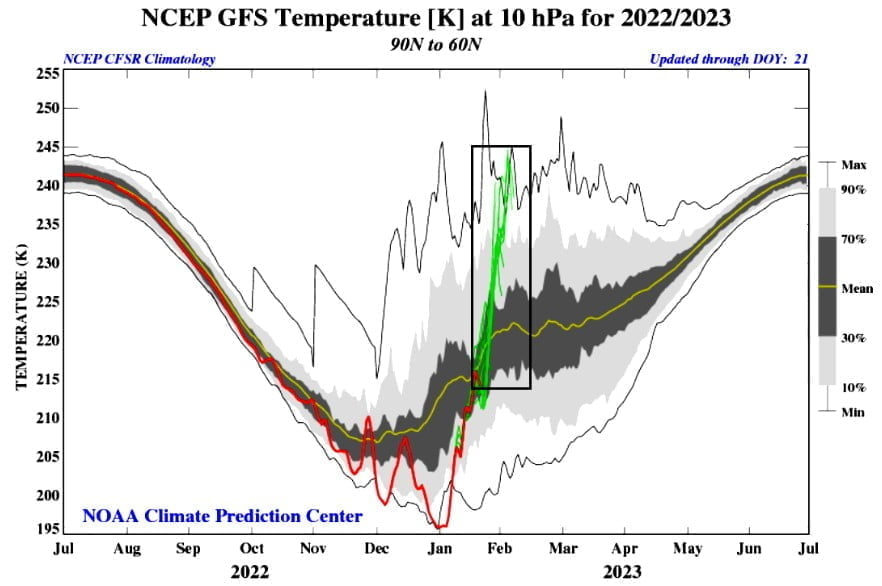Stratospheric temperature rise signals weakened polar vortex and Arctic air outbreaks in the northern hemisphere

The polar vortex, a large area of low pressure in the upper atmosphere that typically sits over the poles, is set to weaken as a sudden stratospheric warming (SSW) event unfolds in the northern hemisphere. This event has the potential to have a significant impact on winter weather, as it allows cold Arctic air to escape and cause outbreaks in Europe, Asia, Canada, and the United States.
- While it’s still too early to be sure of the exact outcome, weather models and temperature anomalies point towards a weakening of the polar vortex and the potential for cold air outbreaks in the northern hemisphere in the weeks ahead
The temperatures in the stratosphere are already on the rise as a warming wave develops, as seen in the image below by NOAA/CPC. The current forecast calls for a strong incoming event that could raise the stratospheric temperatures to record high levels for this time of year.

As seen in the temperature anomalies in the stratosphere, they have been colder than normal for most of the season so far. However, the forecast shows a direct opposite pattern, with strong warm anomalies incoming.
The ECMWF model shows warm anomalies taking over the stratospheric polar regions in the first days of February. While the polar vortex will be severely weakened and disrupted, it will still be present.
The location of cold air outbreaks may depend on where the polar vortex splits or displaces, as well as other factors such as El Niño Southern Oscillation (ENSO), that are influencing the weather at the time.
A minor SSW, which is looking likely, is generally less likely to impact surface weather patterns than a major SSW. A minor SSW will likely cause a displacement of the stratospheric polar vortex over the next couple of weeks, with the polar vortex modeled to be displaced towards northern Europe.
A major SSW can still occur after one or two minor warmings that weaken the polar vortex prior, and there is some support from ensembles for this to occur. Though most recent model runs suggest only 20-30% chance of a major SSW with zonal mean zonal winds at 10 hPa 60N reaching 0 m/s.
While every SSW event is different, around 66% of them lead to colder conditions.
For example, the SSW in February 2018 led to the ‘beast from the east’ later that month and into early March, whereas the SSW in January 2019 had no significant impact for the UK and later Europe. The one in 2021, on the other hand, led to a significant cold outbreak event across much of Europe.
The polar vortex is a large area of low pressure in the upper atmosphere that typically sits over the Earth’s poles. It is a persistent and large-scale circulation pattern that is created by the cold temperatures at the poles, which cause the air to sink and create high pressure. It’s strongest in the winter and weakest in the summer. The polar vortex is not a single entity but rather a series of circulating winds that are strongest at the poles but can also extend to lower latitudes.
A Sudden Stratospheric Warming (SSW) event occurs when there is a rapid increase in temperature in the stratosphere, which is the layer of the atmosphere above the troposphere (where we live). This increase in temperature can cause the polar vortex to weaken or even split, which can have a significant impact on weather patterns in the northern hemisphere. These events typically occur in the winter, and can last for several weeks.
During an SSW, the westerly winds that normally circulate around the polar vortex can weaken or even reverse direction, allowing cold Arctic air to escape and cause Arctic air outbreaks over Europe, Asia, Canada, and the United States. The effects of a SSW can also be felt at the surface, with colder temperatures and an increased likelihood of snowfall.
It’s important to note that SSW events are not a common phenomenon and are relatively rare, they happen on average every 2 – 3 years, but they are becoming more frequent in recent years. Also, it’s worth noting that not all SSWs lead to a major impact on weather patterns, some of them are minor and have a limited effect.
References:
1 A strong Stratospheric Warming event is about to start, impacting the Polar Vortex as we head into the final month of the Winter Season – Severe Weather Europe – January 23, 2023
2 Is a Sudden Stratospheric Warming occurring and will it bring the Beast from the East? – Net Weather – January 22, 2023
Featured image credit: NOAA/CPC

Commenting rules and guidelines
We value the thoughts and opinions of our readers and welcome healthy discussions on our website. In order to maintain a respectful and positive community, we ask that all commenters follow these rules.